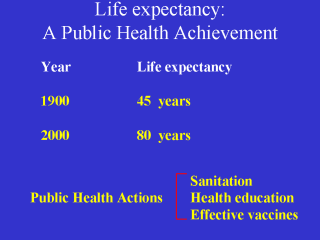 |
For example, if we look back at the beginning of the
century we have just completed, we can see a dramatic change in one of the
prominent markers of overall health status: life expectancy. A person born in
1900 could expect to live, on average, to the age of 45. Today, life
expectancy is nearly 80 years. What may surprise you about this statistic is
not that we’ve gained 35 years of longevity, but rather where these gains
have come from. In fact, only 5 or so of these “extra” years can be
attributed to advances in clinical medicine. Public health can take the credit
for the other 30 years, thanks to improvements in sanitation, health
education, the development of effective vaccines, and other advances. As the
eminent British historian of the Wellcome Institute, Roy Porter, has observed,
“the retreat of the great lethal diseases was due in the first instance,
more to urban improvements, superior nutrition and public health than to
curative medicine.”
I do not mean to minimize the phenomenal and exciting contributions of
clinical medicine and technology. We can and should expect great things from
the exploration of the frontiers of medicine. But I would argue that for the
population as a whole, the less visible contributions of public health have
historically yielded a disproportionate pay-off in longevity and quality of
life. |
